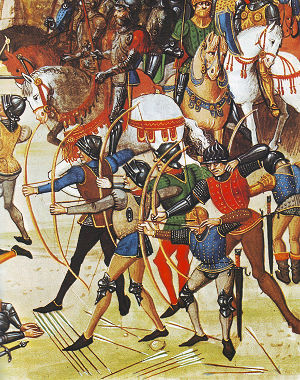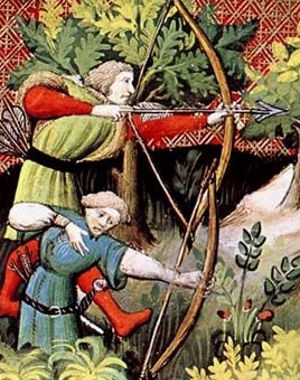Longbow & Recurve Bow Archery 
AEMMA continues the research and development in the resurrection and reconstruction of medieval martial arts extends to the realm of medieval longbow. The longbow is constructed in the traditional manner of a minimum of 5' 6", of a historical authentic "D" cross-section in which the shooting style is by an instinctive method not incorporating artificial aids such as scopes, arrow rests or sites. Evidence of bows bearing cross-sections of the traditional "D" shape, others rounded while others flat have been in use for approximately 5,000 years. [1]





Although the longbow was not considered one of the "knightly weapons", it was a strategic weapon of war. Examples of its capability can be seen at such battles as the Battle of Crécy, August 26, 1346. [2] [3] [4] This battle amongst the many fought during the 100 Years War, was a victory for the English longbow men by the army of King Edward III and King Philip IV of France. The French army numbering approximately 30,000 - 40,000 against the English army of approximately 12,000 - 13,000 of which 6,000 - 7,000 were longbow men, each carrying 2 sheafs of 24 arrows. With a range of approximately 300m, the English longbow men shot volley after volley of arrows. For more info on this battle, visit Longbow-Archers.
Sources of archery equipment (longbow and recurve bows)
Longbows can be purchased for up to $150 CAD that possess a draw weight of 45 lbs. These bows are perfectly suited for the beginner student. A good source for entry-level longbows of 45 lbs draw weight is The Bow Shop. This English Longbow is made from Red Oak backed with linen. It pulls approximately 30 pounds at 28 inches. The bow is 72 inches in length and up to 1 1/4 inches in width at the handle. It is flat on the back and rounded on the belly. You can request up to 45 pounds for approximately the same price range.
Arrows can be purchased for approximately $65/dozen from The Bow Shop located in Waterloo, ON. The arrows have unfinished, wooden shafts and target-type of tips. Other accessories can be purchased from the same shop and which can be shipped to Toronto for a small shipping fee.
Heavier bows of 60 lbs or more can be purchased from the UK at Quicks Archery, nicely finished with hocks made from horn. They are priced at approximately $500 CAD.
Periodically, AEMMA hosts an archery workshop whereby, students can learn and make their own longbows. Watch the AEMMA site for announcements for the next workshop.
- A longbow is a type of bow that is tall—roughly equal to the height of the user; allowing the archer a fairly long draw, at least to the jaw. A longbow is not significantly recurved. Its limbs are relatively narrow so that they are circular or D-shaped in cross section. Flatbows can be just as long; the difference is that, in cross-section, a flatbow has limbs that are approximately rectangular. source: Wikipedia. Longbow. Retrieved: January 19, 2017.
- The Battle of Crécy (1346), also called Battle of Cressy, was an English victory during the Edwardian phase of the Hundred Years' War. Coupled with the later battles of Poitiers (also fought during the Edwardian phase) and Agincourt, it was the first of the three major English successes during the conflict. The battle was fought on 26 August 1346 near Crécy, in northern France. An army of English, Welsh, and allied troops from the Holy Roman Empire led by Edward III of England, engaged and defeated a much larger army of French, Genoese and Majorcan troops led by Philip VI of France. Emboldened by the lessons of tactical flexibility and utilisation of terrain learned from the earlier Saxons, Vikings and the recent battles with the Scots, the English army won an important victory. source: Wikipedia. Battle of Crécy. Retrieved: January 19, 2017.
- The weapon of King Edward’s archers was a six foot yew bow discharging a feathered arrow a cloth metre in length. Arrows were fired with a high trajectory, descending on the approaching foe at an angle. The rate of fire was up to one arrow every 5 seconds against the crossbow’s rate of a shot every two minutes; the crossbow requiring to be reloaded by means of a winch. For close quarter fighting the archers used hammers or daggers to batter at an adversary’s armour or penetrate between the plates. source: British Battles. Battle of Crécy. Retrieved: January 19, 2017.
- On August 26, 1346, during the Hundred Years’ War (1337-1453), the army of England’s King Edward III (1312-77) annihilated a French force under King Philip VI (1293-1350) at the Battle of Crecy in Normandy. The battle, which saw an early use of the deadly longbow by the English, is regarded as one of the most decisive in history. source: History Channel. Battle of Crécy. Retrieved: January 18, 2017.

